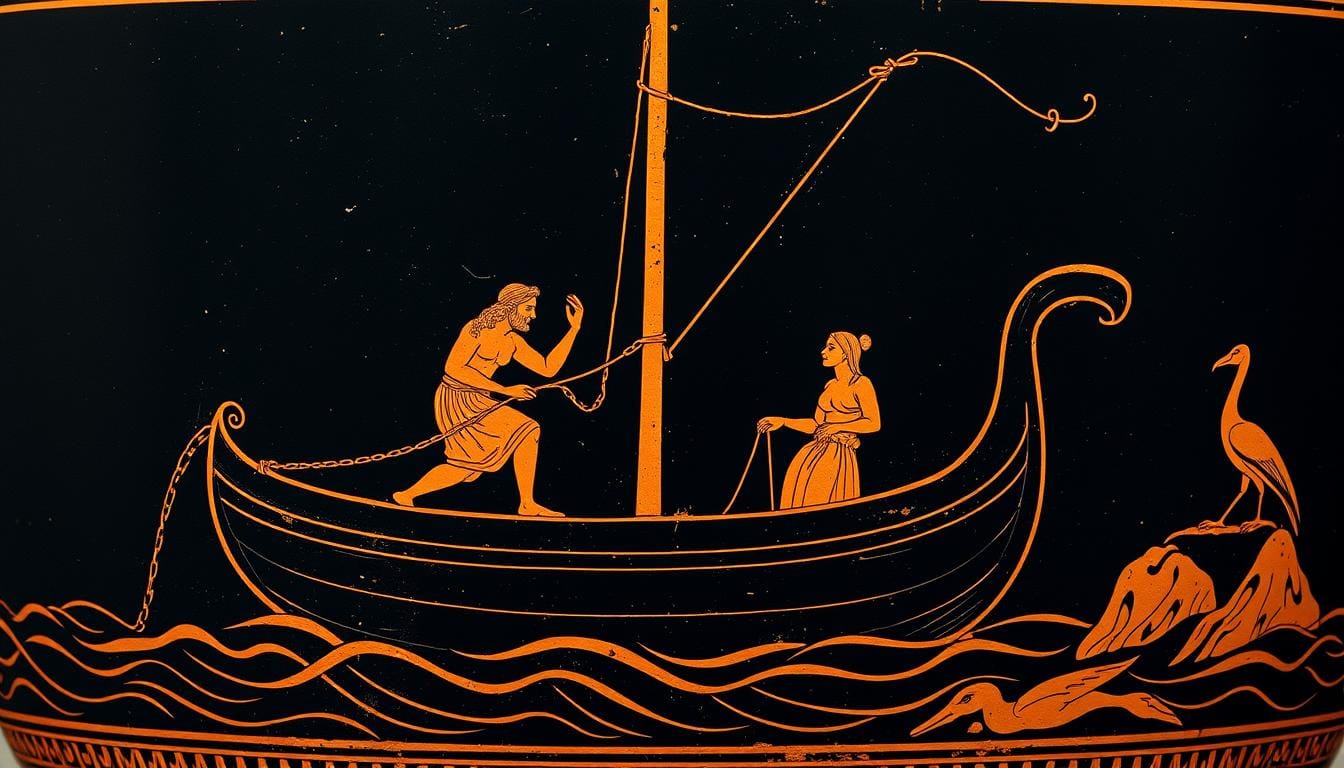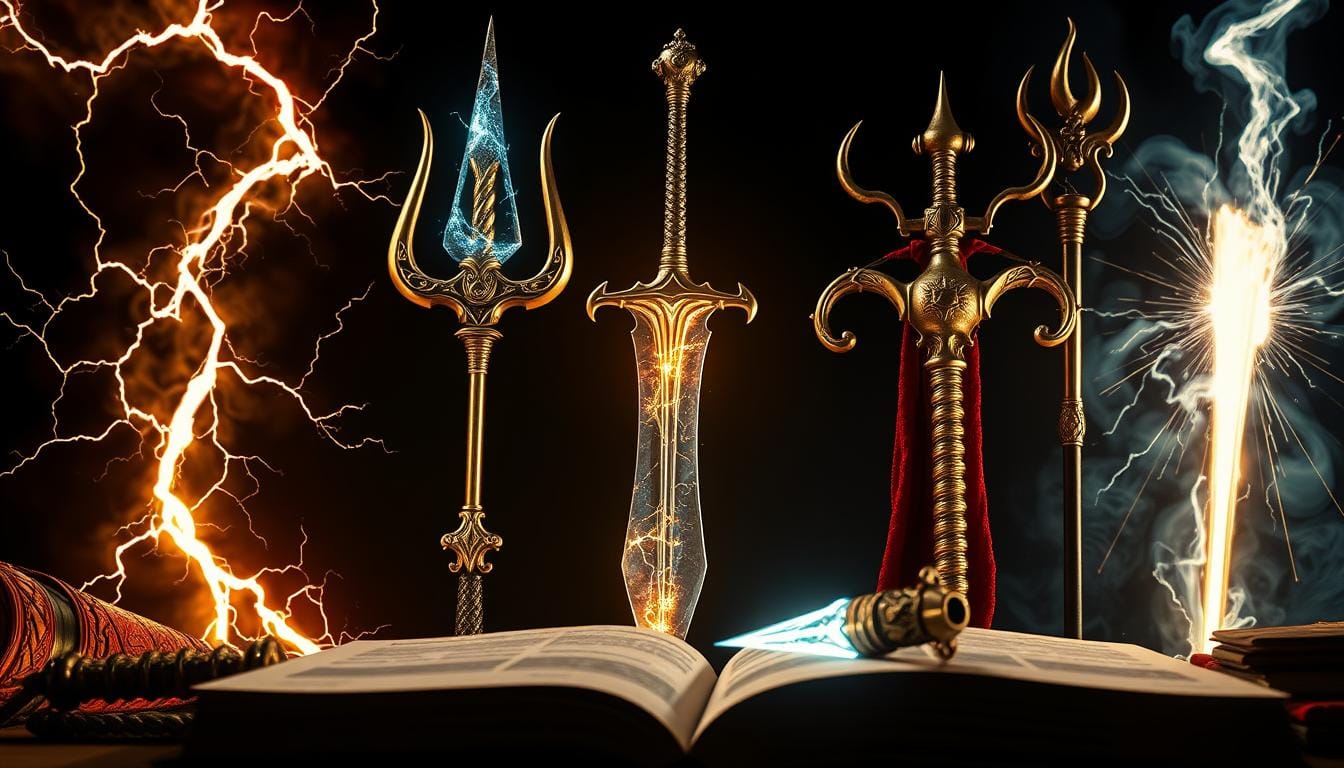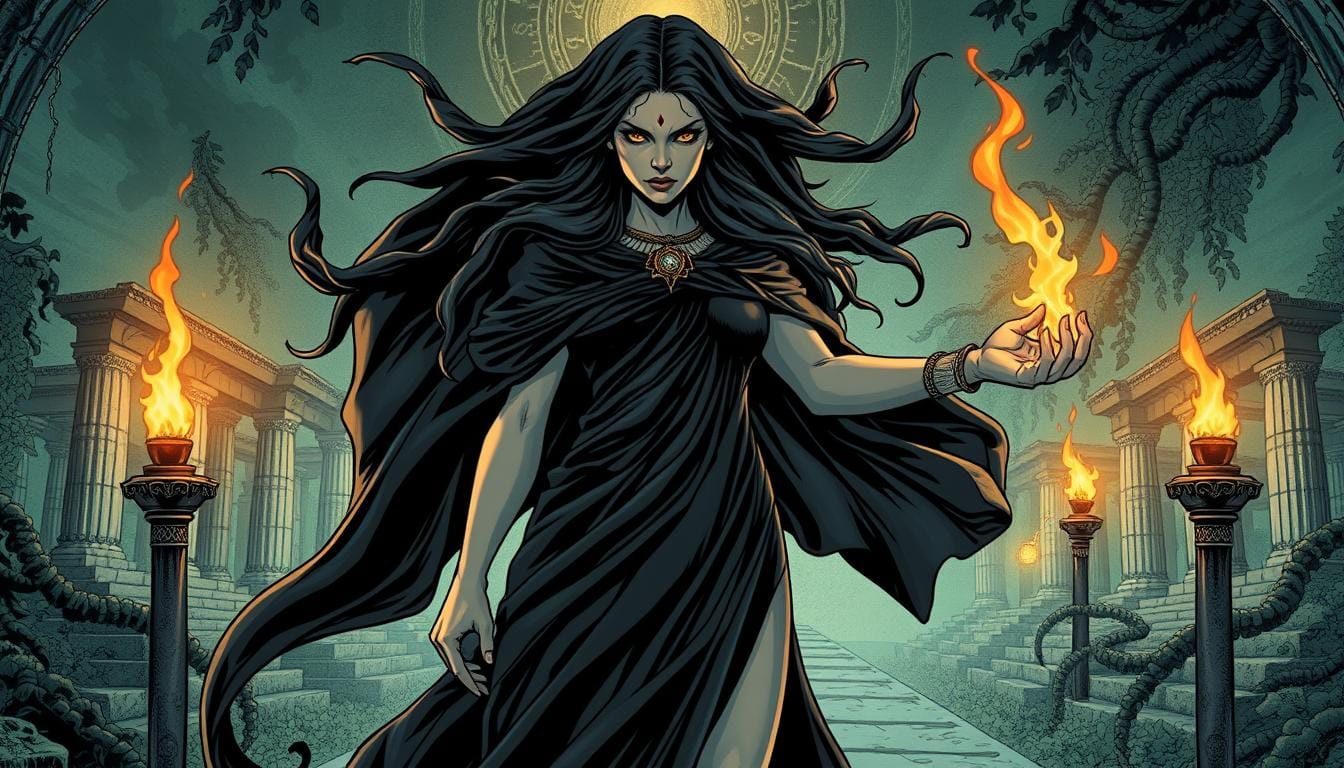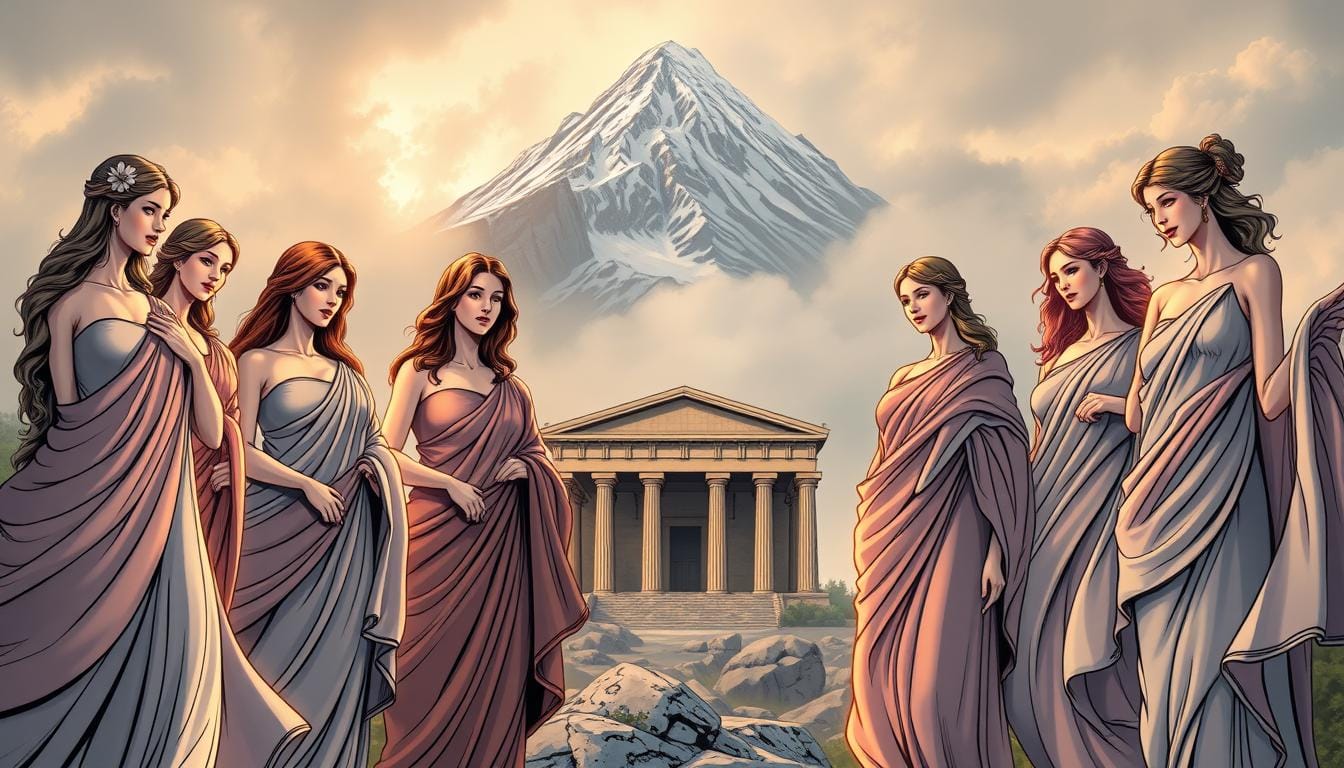Over 150 modern English phrases come from ancient myths. Yet, many don’t know they’re using the language of gods and heroes every day. When we talk about an “Achilles’ heel” or opening “Pandora’s box,” we’re tapping into stories that amazed people thousands of years ago.
These stories were more than just tales for ancient people. They were mirrors reflecting their deepest beliefs, fears, and dreams. Today, these stories influence movies, books, and even brand names.
Learning about mythology basics is easy. It’s about exploring characters whose stories have shaped Western culture for ages. These aren’t just old stories—they’re tales that connect with our universal human experiences.
From books to our everyday talks, these ancient stories are surprisingly relevant today. They give us insights into relationships, power, love, and loss that are just as powerful now.
Key Takeaways
- Over 150 common English expressions originate from ancient mythology
- These stories served as cultural mirrors for ancient civilisations’ beliefs and values
- Modern films, literature, and brands frequently draw inspiration from mythological themes
- Understanding mythology requires no formal classical education—just curiosity
- Ancient narratives address universal human experiences that remain relevant today
- Mythological references appear throughout contemporary culture and daily conversation
What is the Greek Pantheon?
The Greek gods and goddesses formed a complex religious system. It deeply influenced ancient life. This system wasn’t just a list of gods. It was a way to understand the world and our place in it.
The gods were like us, with emotions and flaws. Zeus was jealous, Aphrodite was vindictive, and Poseidon was temperamental. This made them easy to relate to.
Definition and Significance
Ancient Greek religion revolved around twelve major gods and many minor ones. The word “pantheon” means “all gods” in Greek. It shows the importance of these divine beings.
These gods weren’t perfect. They felt pride, jealousy, and contempt. This made them seem more real to people.
The gods explained natural events to the ancient Greeks. Earthquakes were Poseidon’s anger, lightning Zeus’s wrath, and seasons Persephone’s journey. This gave meaning to the world.
Cultural Influence
The Greek gods and goddesses shaped many areas of ancient Greek life. They influenced art, literature, politics, and social structures. Temples and festivals were key parts of community life.
City-states had their own gods. Athens worshipped Athena, Sparta Artemis. These gods guided military campaigns and trade.
People sought divine advice and made offerings before big decisions. Ancient Greek religion was part of everyday life. It wasn’t separate from the world.
The gods’ stories are timeless. They deal with universal themes like power, love, and betrayal. Their stories are relatable because they face human challenges.
Key Olympian Gods and Goddesses
The Olympic pantheon featured extraordinary gods whose stories captivated ancient Greek society. These Mount Olympus deities had human-like personalities and divine powers. Their stories of love, jealousy, and conflict explained natural phenomena and offered moral guidance.
Seeing these gods as complex characters helps us understand them better. Each deity controlled specific aspects of life and nature. They influenced everything from weather to human relationships.
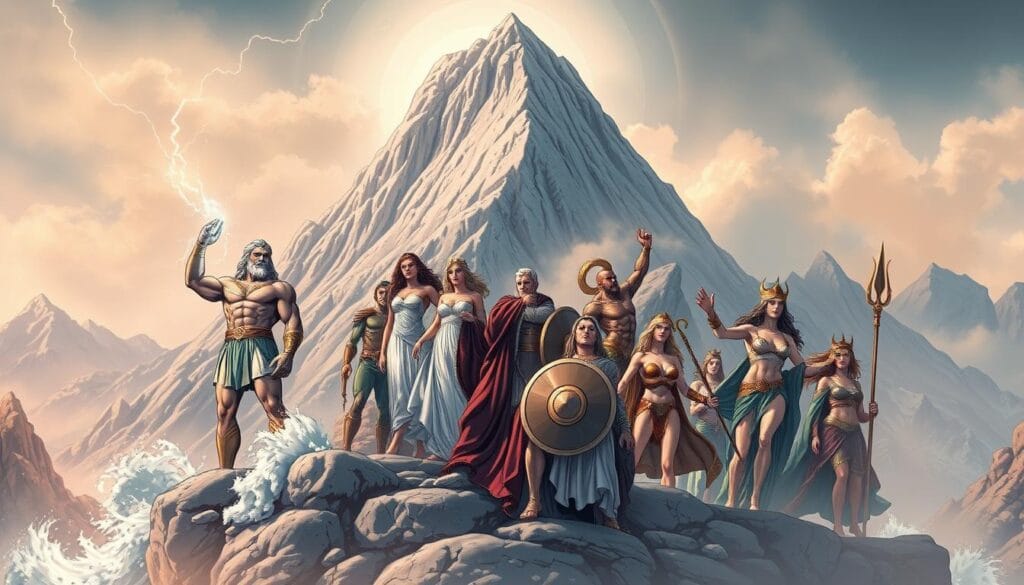
Zeus: The King of the Gods
Zeus ruled as the supreme authority among all Olympic gods, wielding thunderbolts as his weapon. He took over Mount Olympus after defeating his father, Cronus. Despite his divine status, Zeus had human flaws that made him both feared and criticised.
The king of gods was known for his many affairs with goddesses and mortal women. He used disguises like a swan, a bull, and golden rain to pursue his desires. His infidelities created many mythological heroes and sparked conflicts with his wife, Hera.
Zeus’s quick temper could bring devastating consequences to mortals and gods alike. When angry, he might hurl thunderbolts, cause floods, or curse entire cities. Yet, he also ensured oaths were kept and punished those who broke divine laws.
Hera: The Goddess of Marriage
Hera presided over marriage and family life, despite her husband’s constant betrayals. As Zeus’s wife and sister, she held significant power on Mount Olympus. She focused much of her energy on seeking revenge against her husband’s lovers and their children.
Her jealousy became legendary throughout Greek mythology. Hera pursued Zeus’s mistresses with relentless fury, transforming them into animals or cursing them with terrible fates. She targeted the hero Heracles, Zeus’s son with a mortal woman, subjecting him to numerous trials and hardships.
Despite her vengeful nature, Hera protected married women and blessed legitimate unions. Greek brides often sought her favour for happy marriages. Her sacred animals – the peacock and cow – symbolised her majesty and nurturing aspects.
Poseidon: God of the Sea
Poseidon controlled the vast oceans, earthquakes, and horses with his mighty trident. As Zeus’s brother, he was one of the most powerful simplified Greek gods. He commanded respect from sailors and coastal communities throughout the ancient world.
His temperamental nature matched the unpredictable seas he ruled. When pleased, Poseidon granted safe voyages and calm waters. But when angered or slighted, he could unleash devastating storms, create massive waves, or cause earthquakes that toppled entire cities.
The god’s rivalry with other deities often had serious consequences for mortals. His famous contest with Athena for patronage of Athens resulted in him striking the ground with his trident, creating a saltwater spring. Though he lost to Athena’s gift of the olive tree, this myth explained the connection between the sea god and the city.
Athena: Goddess of Wisdom
Athena emerged fully grown from Zeus’s head, wearing armour and ready for battle. This unique birth story highlighted her role as the goddess of wisdom and strategic warfare. She combined intellectual prowess with military skill.
As patron goddess of Athens, Athena’s influence shaped one of Greece’s most important city-states. The magnificent Parthenon stands as testament to her significance in Greek civilisation. It represents the pinnacle of architectural achievement and cultural devotion.
Athena differed from other war deities by favouring strategy over brute force. She guided heroes like Odysseus through clever solutions, not violent confrontations. Her symbols – the owl representing wisdom and the olive tree symbolising peace – reflected her balanced approach to conflict resolution.
The goddess also patronised craftspeople, mainly those working with textiles and pottery. Her skills in weaving were so renowned that she competed with mortals, as shown in the myth of Arachne. This demonstrated both her artistic talents and her intolerance for hubris.
Lesser-Known Deities
While Zeus and his friends ruled Mount Olympus, other gods explained death, nature, and the wild. These gods, though not always counted among the twelve main gods, were key in ancient Greek life. Their tales show how Greeks saw the balance between civilisation and nature.
Many of these lesser-known gods had powers that touched mortal lives. They ruled areas the Olympians rarely visited, from the underworld to wild forests.
The Ruler of the Dead
Hades is often seen as evil today, but the ancient Greeks saw him differently. He was Zeus’s elder brother and ruled the underworld, guiding the dead.
The underworld was more than just a place of punishment. It had different areas for different souls. Heroes and the virtuous went to the Elysian Fields, while the wicked were in Tartarus.
Hades’ famous story is about his marriage to Persephone, Demeter’s daughter. When he took her, Demeter’s sadness made the earth barren. This myth explained the seasons. Persephone’s return brought spring, and her going back to Hades meant winter.
Hades rarely left his realm. He was neither cruel nor kind, just. The Greeks respected him, knowing death was part of life.
The Fierce Huntress
Artemis was the wild, untamed nature that civilisation couldn’t control. As Apollo’s twin sister, she chose a path different from her brother’s arts and prophecy.
She wanted eternal virginity and independence. Her followers, the Hunters of Artemis, also vowed to live apart from men. She protected young animals and women in childbirth but could be harsh to those who offended her.
The story of Actaeon shows her justice. When he saw her bathing, she turned him into a stag. His dogs then killed him, not knowing it was their master.
Artemis also ruled the moon, balancing Apollo’s sun. She had a silver bow and arrows that could bring plague or death. Her worship was strong in Ephesus, where her temple was one of the Seven Wonders.
| Deity | Domain | Key Symbols | Personality Traits |
|---|---|---|---|
| Hades | Underworld, Death, Wealth | Helmet of Invisibility, Cerberus, Pomegranate | Just, Stern, Rarely Emotional |
| Artemis | Hunt, Moon, Wilderness, Childbirth | Silver Bow, Deer, Cypress Tree | Independent, Fierce, Protective |
| Persephone | Spring, Underworld Queen | Pomegranate, Flowers, Torch | Dual Nature, Gentle yet Powerful |
| Demeter | Harvest, Agriculture, Nature | Wheat Sheaf, Cornucopia, Poppy | Nurturing, Protective, Grief-stricken |
These Greek gods explained important parts of human life that the major Olympians didn’t cover. Their stories gave ancient Greeks meaning in death, seasons, and our connection to nature.
Myths and Legends
Greek myths are more than just stories. They give us insights into human nature. These tales help us understand our deepest fears, desires, and dreams.
These stories have influenced many. George Lucas, for example, was inspired by Greek myths when creating Star Wars. Scholar Joseph Campbell showed how these myths shape our stories today.
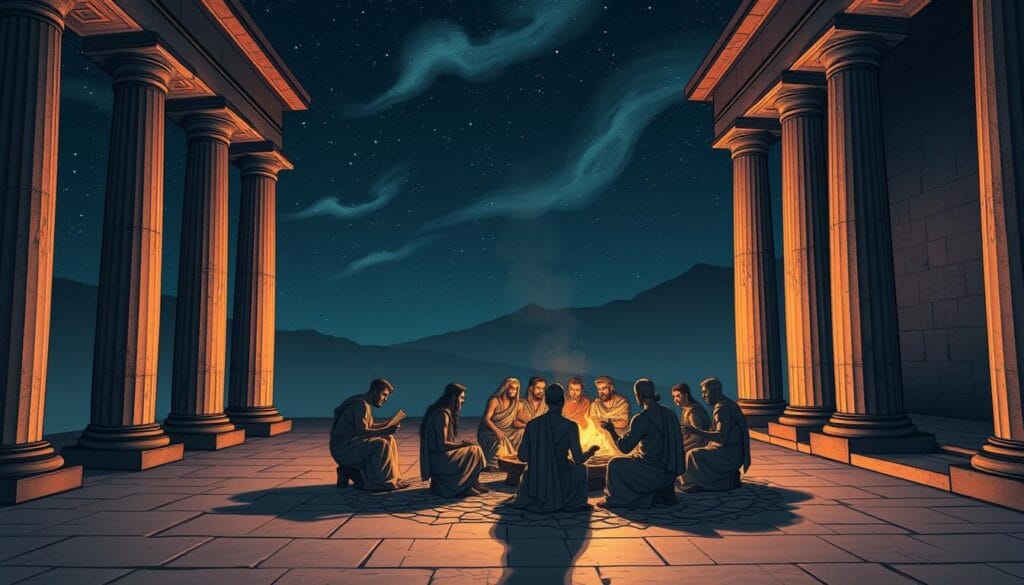
The Birth of Everything
Greek myths tell us how the world began. They start with Chaos, a void that gave birth to Earth, the underworld, and love.
The Titans ruled first, but Kronos ate his children to avoid being overthrown. Zeus defeated his father, starting the Olympian order we know today. These myths show how ancient Greeks thought about existence and power.
“In the beginning was Chaos, the first of all things to come into being.”
These stories deal with big themes. They talk about the struggle between generations, the cost of power, and the cycle of rise and fall.
Heroes and Their Journeys
Greek heroes set the pattern for modern stories. Figures like Perseus, Theseus, and Heracles go on quests that reflect our own growth. They face challenges, overcome them, and return changed.
This hero’s journey is seen in many modern tales. From Star Wars to superhero movies, the same story is told: ordinary people called to adventure, facing trials, and becoming champions.
| Hero’s Journey Stage | Greek Example | Modern Parallel | Psychological Meaning |
|---|---|---|---|
| The Call | Perseus receives quest to slay Medusa | Luke Skywalker meets Obi-Wan | Awakening to purpose |
| Trials | Heracles’ twelve labours | Harry Potter’s challenges | Overcoming personal limitations |
| Transformation | Theseus becomes king | Neo becomes “The One” | Achieving full capacity |
| Return | Heroes bring gifts to society | Heroes save their communities | Sharing wisdom with others |
These stories touch on universal human experiences. They teach us that growth comes from struggle, greatness requires sacrifice, and true heroism is in serving others.
Understanding Greek myths shows their timeless value. They offer guidance on life’s challenges, inspiring us to achieve greatness through courage and perseverance.
The Role of Mythology in Ancient Greece
The gods and goddesses of ancient Greece were not just distant figures. They were active in every part of daily life. Greek mythology was at the heart of society, explaining natural events, guiding morals, and shaping social structures. This easy guide to Greek Pantheon shows how these beliefs deeply influenced ancient Greek culture.
Ancient Greeks saw their world through myth. Every sunrise was Helios driving his chariot across the sky. Storms meant Poseidon’s anger was stirring the seas. It was not just superstition but a way of understanding the universe.
Religion and Daily Life
Greeks made religion a part of their daily lives. They started each day with morning prayers to household gods. Evening prayers honoured the gods who protected their homes and families.
Farmers prayed to Demeter before planting, hoping for a good harvest. Sailors offered sacrifices to Poseidon before sailing, seeking calm seas. Students invoked Athena’s wisdom before exams or discussions.
Craftsmen prayed to Hephaestus, the divine blacksmith. Merchants sought Hermes’ protection for trade. Even simple tasks like cooking and cleaning were seen as religious acts, with specific gods overseeing them.
These practices were not burdensome but expressions of gratitude and respect. Greeks believed the gods influenced human lives, rewarding the pious and punishing the arrogant. This belief linked moral behaviour to religious observance.
Festivals and Worship
Greek festivals turned cities into vibrant celebrations. These were not solemn but joyful events that united people. They brought together people from all walks of life.
The Panathenaea festival in Athens honoured Athena with processions, competitions, and performances. It created a shared identity and purpose. The festival celebrated Athens’ connection to Athena and civic pride.
Dionysiac festivals combined worship with theatre, giving birth to Greek drama. They featured wine, music, and competitions that explored human nature and justice. These festivals taught moral lessons through stories.
| Festival | Deity Honoured | Key Activities | Social Function |
|---|---|---|---|
| Panathenaea | Athena | Processions, athletic contests, sacrifices | Civic unity and pride |
| Dionysiac Festivals | Dionysus | Theatre performances, wine ceremonies | Cultural education and entertainment |
| Olympic Games | Zeus | Athletic competitions, religious ceremonies | Pan-Hellenic cooperation |
| Eleusinian Mysteries | Demeter and Persephone | Secret initiation rituals | Spiritual transformation |
Local communities held smaller festivals throughout the year. These celebrated regional deities and seasonal changes. They strengthened neighbourhood bonds and kept the mythological tradition alive.
Religious festivals also boosted local economies. They attracted visitors who increased trade. Pilgrims came from far to join major celebrations, spreading Greek culture across the Mediterranean.
Mythology was woven into daily life and festivals. This easy guide to Greek Pantheon shows how it shaped ancient society. It gave meaning, structure, and identity to Greek culture for centuries.
The Concept of Fate and Destiny
Fate and destiny were key in Greek myths, setting limits even for gods. This intro to Greek pantheon idea shows how Greeks saw the balance between choice and fate. Gods were unpredictable, and humans often got caught in their battles.
Greek myths saw fate as unchangeable. Even Zeus, the top god, couldn’t change destiny once it was set. This created a deep tension in every myth.

The Three Sisters Who Controlled All Life
The Moirai, or Fates, were three sisters who ruled over mortal life. Clotho started the thread of life, deciding when someone was born. Her sister Lachesis measured how long that life would last.
The most feared was Atropos, who cut the thread at death. No prayer or divine help could stop her once she decided it was time.
These sisters were beyond the gods’ control. Their power was about the natural order of life. This intro to Greek pantheon idea explained why even devout people faced bad fates.
| Sister | Role | Symbol | Power Over |
|---|---|---|---|
| Clotho | The Spinner | Spindle | Birth and Beginning |
| Lachesis | The Allotter | Measuring Rod | Life’s Duration |
| Atropos | The Inevitable | Shears | Death and Endings |
How Destiny Shaped Heroic Tales
Greek heroes faced their biggest challenges in facing their fates. Achilles knew he’d die young if he chose fame over a long life. Yet, he chose his destiny, seeing heroism as accepting its consequences.
Oedipus is a tragic example of fate’s power. Despite trying to avoid his prophecy, he fulfilled it. His story shows fate as a test of character, not just acceptance.
These stories in the intro to Greek pantheon show true courage is facing destiny with honour. Heroes became legends not by avoiding fate, but by meeting it with courage and determination.
Symbols and Icons of the Pantheon
Greek mythology’s stories are powerful, but its symbols are even more iconic. These symbols helped ancient people identify and honour their gods. Today, they appear in logos and monuments, showing their lasting appeal.
The symbols of Greek gods weren’t random. They showed each god’s powers and personality. This created a visual language that everyone could understand.
Divine Attributes and Sacred Objects
Every Greek god had unique symbols. Zeus had the thunderbolt, showing his power over the sky. This symbol was seen everywhere in ancient times.
Athena’s owl stood for wisdom. Her shield and spear showed her bravery. The owl was chosen for its ability to see in the dark, like wisdom does.
Poseidon’s trident was a sign of his power over the sea. It could also cause earthquakes. This symbol is well-known in Greek myths.
Other gods had meaningful symbols too. Aphrodite’s dove meant love and beauty. Apollo’s lyre stood for music and poetry.
| Deity | Primary Symbol | Secondary Symbol | Domain Represented |
|---|---|---|---|
| Zeus | Thunderbolt | Eagle | Sky and Divine Authority |
| Athena | Owl | Shield and Spear | Wisdom and Warfare |
| Poseidon | Trident | Horse | Sea and Earthquakes |
| Apollo | Lyre | Laurel Wreath | Music and Prophecy |
| Artemis | Silver Bow | Deer | Hunt and Moon |
Architectural Marvels and Artistic Legacy
The Parthenon is a marvel of Greek architecture. It shows the beauty and precision of ancient Greek design. It’s a temple dedicated to Athena.
Nashville’s Parthenon is a full-scale replica. Built in 1897, it makes Nashville known as the “Athens of the South”. It inspires visitors with its beauty.
Greek temples set the standard for Western architecture. The Doric, Ionic, and Corinthian columns are used today. They add elegance to buildings around the world.
Ancient Greek artists were skilled in telling stories through art. Red-figure and black-figure pottery showed complete myths. This made mythology accessible to everyone.
Today, public art often uses Greek themes. Fountains with Poseidon’s trident and statues of Athena show the lasting impact of Greek symbols.
Classical designs and columns in modern buildings come from ancient Greece. They bring a sense of permanence and connection to our past.
Museums worldwide showcase Greek art and artefacts. Places like the British Museum and the Acropolis Museum in Athens preserve this legacy. They inspire artists today.
Modern Interpretations and Influence
Greek mythology thrives in contemporary culture. These ancient tales captivate audiences worldwide. They show their timeless appeal. Modern creators often use these stories and characters.
The influence is seen everywhere: in literature, movies, brand names, and idioms. Films like Troy and the upcoming 300 come from these myths.
George Lucas said many Star Wars ideas came from Greek mythology. This shows how these stories shape modern tales.
Pop Culture References
Mythological names and concepts are all around us. Sports teams like the Tennessee Titans take their names from ancient figures. Technology companies often choose mythological names for their brands.
Amazon is named after the warrior women of Greek legend. This shows the strength and independence of these mythical figures. Many businesses follow this naming trend.
Superhero comics use mythological archetypes. Characters like Wonder Woman are inspired by Amazonian warriors. Video games also feature Greek gods and heroes, introducing these stories to new generations.
Literature and Film
Contemporary storytellers find inspiration in these timeless tales. Rick Riordan’s Percy Jackson series makes mythology accessible to young readers. These books bring classical stories to life through modern adventures.
Blockbuster films often adapt mythological themes. Troy brought the Trojan War to cinema screens worldwide. Wonder Woman reimagines Amazonian legends for today’s audiences.
Directors often thank Greek mythology for their work. The hero’s journey, from these ancient stories, is key to modern storytelling. Characters from ancient Greece continue to inspire compelling stories.
| Modern Medium | Greek Influence | Popular Examples | Target Audience |
|---|---|---|---|
| Literature | Character archetypes and heroic journeys | Percy Jackson series, Madeline Miller’s novels | Young adults and children |
| Cinema | Epic narratives and mythological themes | Troy, Wonder Woman, Clash of the Titans | General audiences |
| Video Games | Gods as characters and mythological settings | God of War, Assassin’s Creed Odyssey | Gaming enthusiasts |
| Brand Names | Mythological references for strength and power | Amazon, Nike, Oracle | Consumers worldwide |
These modern interpretations keep Greek mythology alive in today’s culture. Ancient stories offer powerful metaphors for our times, showing their lasting relevance.
The Heroes of Greek Mythology
Greek mythology’s heroes show the eternal battle between human limits and divine dreams. They faced incredible challenges, fought fearsome monsters, and overcame personal weaknesses to gain eternal fame. Their stories inspire us today by tackling universal themes like courage, sacrifice, and redemption.
These heroes’ stories are more than just tales of glory. Ancient Greece was filled with legendary figures whose adventures shaped its culture and morals. From Oedipus’s tragic fate to Sisyphus’s eternal punishment, these stories teach us about the results of our actions and the power of the gods.
The Trojan War gave rise to many heroic legends. Achilles showed the cost of pride and the value of true friendship. Odysseus proved that cleverness can beat brute force. Paris’s story teaches us how personal choices can harm entire societies.
“The hero’s journey is not just about external conquest, but internal transformation.”
Perseus and the Gorgon's Challenge
Perseus is the quintessential young hero facing incredible odds. His quest to defeat Medusa is a blueprint for many adventure stories. Divine help, magical tools, and impossible challenges are key elements in these tales.
Perseus’s journey starts with a task to save his mother. He is given gifts from the gods – winged sandals, a reflective shield, and an invisible helmet. This shows how courage and divine aid can conquer even the most daunting challenges.
Beating Medusa wasn’t just about bravery. It needed intelligence, strategy, and the wisdom to accept help. These qualities make his story a timeless coming-of-age tale.
Heracles and His Twelve Labours
Heracles is the most renowned hero in Greek mythology, blending human strength with divine blood. His twelve labours were tests of character, creativity, and moral growth. Each task revealed different aspects of his nature.
These labours began as punishment for a crime committed in madness. This backstory turns Heracles from a simple strongman into a complex figure seeking redemption. His journey shows how even the strongest heroes must face the consequences of their actions.
From slaying the Nemean Lion to capturing Cerberus, each labour was unique. Some needed brute strength, others cleverness or diplomacy. This variety shows that true heroism requires many qualities working together.
The impact of these stories is seen in modern psychology and literature. King Midas taught us about the dangers of greed and the true value of wealth. Oedipus’s story explores the debate between fate and free will, captivating scholars today. These tales help us understand human nature and moral growth, remaining relevant in today’s world.
Connection to Philosophy
Ancient Greek philosophers saw myths as a rich source for exploring big questions. These stories were not just for fun. They were tools to understand life, morality, and reality.
Philosophers saw myths as valuable for deep thinking. They didn’t see them as just stories. Instead, they were seen as ways to grasp life’s deeper truths.
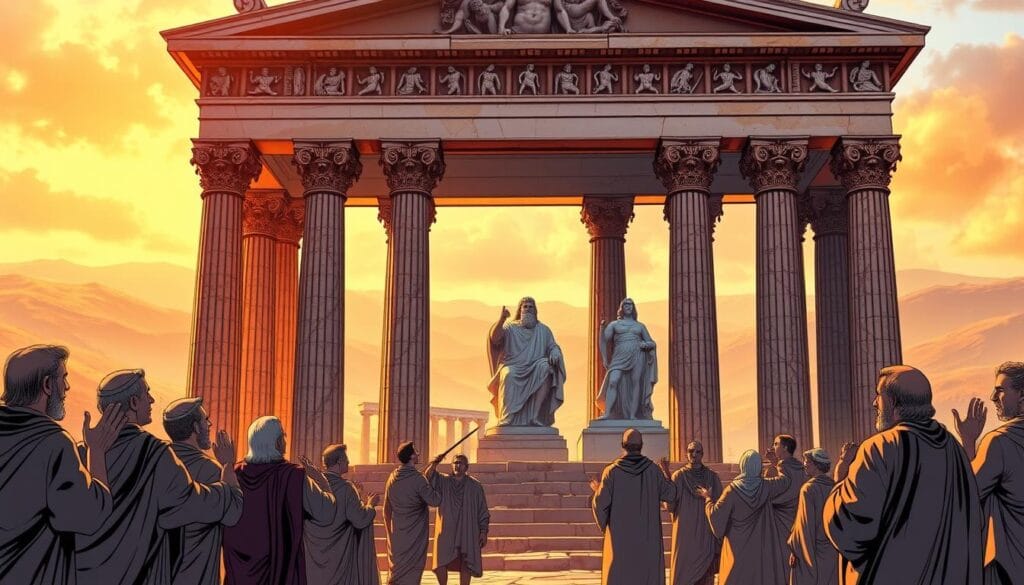
Influence on Ancient Philosophers
Plato is famous for using myths in his thinking. His Allegory of the Cave uses myth to explain complex ideas. It’s a powerful way to talk about knowledge and reality.
Plato used many myths in his dialogues. These stories helped explain abstract ideas. His Republic includes the Myth of Er, which talks about justice and what comes after life.
Stoic philosophers also valued myths. They used stories to teach about virtue and fate. Epictetus and Marcus Aurelius often used myth to show how to face life’s challenges.
These thinkers saw myths as holding psychological truths. They saw that myths reflected human experiences. This helped bridge philosophy and practical wisdom.
Legacy in Modern Thought
Greek mythology’s impact on today’s thinking is strong. Modern psychology, for example, has taken a lot from these stories. Sigmund Freud’s work shows this clearly.
Freud’s Oedipus complex is named after a Greek tragedy. It suggests that myths show universal human stages. The story of Oedipus helps us understand family and psychological growth.
Carl Jung took this idea further. His archetypal psychology finds patterns in human behaviour that match mythological themes. Jung believed these stories show common human experiences.
Joseph Campbell’s work on the monomyth shows Greek myths’ lasting impact on storytelling. His analysis shows that hero stories follow ancient patterns. This idea guides writers and filmmakers today.
| Philosopher/Theorist | Mythological Connection | Modern Application | Key Contribution |
|---|---|---|---|
| Plato | Cave Allegory, Myth of Er | Educational philosophy | Symbolic reasoning |
| Stoics | Heroic examples | Cognitive behavioural therapy | Virtue ethics |
| Freud | Oedipus complex | Psychoanalysis | Unconscious patterns |
| Jung | Archetypal psychology | Analytical psychology | Collective unconscious |
Today’s philosophers find value in ancient myths. They see myths as tackling big questions about us, morality, and meaning. These stories help us deal with today’s ethical challenges.
The link between myths and philosophy shows their deep wisdom. These stories give us insights into human nature, beyond time and culture. Greek myths are more than history; they’re a key to understanding us.
The Pantheon in Regional Variations
The Greek pantheon was not the same everywhere. It changed a lot across different regions and city-states. Ancient Greece was made up of many independent communities. Each one had its own way of relating to the gods.
These local ways of worship made the gods seem more real and important. Maritime cities like Athens focused on Poseidon’s role in safe sea travel. Places that grew crops, like Corinth, honoured Demeter for good harvests. This made the gods feel closer to everyday life.
Distinctive Practices Across City-States
In Athens, Athena was the city’s special goddess. They celebrated her wisdom and bravery with big festivals. The Athenians saw themselves as Athena’s smart and democratic followers.
Sparta, on the other hand, worshipped Artemis and Apollo a lot. Young Spartans went through tough rituals to honour Artemis. This showed their focus on being strong warriors.
Corinth was known for its unique worship of Aphrodite. They even had temple prostitution as part of their rituals. This shocked other Greeks but showed how local traditions shaped their beliefs.
Regional Heroes and Minor Deities
Local heroes were very important in each city. They were often seen as more important than the big Olympian gods. These heroes were known for founding cities, winning battles, or doing amazing things.
Minor deities looked after specific things like rivers, mountains, and harbours. River gods kept the waterways safe. Mountain nymphs protected the peaks. These gods made religion feel more personal and real for the ancient Greeks.
| City-State | Primary Deity | Local Hero | Unique Practice |
|---|---|---|---|
| Athens | Athena | Theseus | Panathenaea Festival |
| Sparta | Artemis | Lycurgus | Warrior Initiation Rites |
| Thebes | Dionysus | Cadmus | Mystery Celebrations |
| Delphi | Apollo | Pythia | Oracle Consultations |
These differences show that Greek mythology was alive and changing. Communities didn’t just follow the same beliefs. They made their own myths to fit their needs. This made Greek culture spread far and wide, yet stay true to each place.
Learning About the Greek Pantheon
Exploring Greek mythology opens a window into ancient civilisation. It shows how these stories have shaped modern culture. The Greek pantheon is full of fascinating tales for those eager to learn.
Essential Reading and Digital Resources
Edith Hamilton’s “Mythology” is a key to understanding Greek gods and goddesses. Stephen Fry’s retellings add humour and make ancient stories relatable. The British Museum’s online collection offers deep insights into mythological artefacts.
Podcasts like “Mythology” by Parcast are engaging. BBC documentaries shed light on archaeological finds that reveal ancient Greek beliefs. These resources suit various learning needs and ages.
Museums and Historic Locations
The British Museum has incredible Greek antiquities, like sculptures of mythological scenes. The Metropolitan Museum of Art in New York displays pottery that tells heroic stories. Athens’ National Archaeological Museum shows artefacts in their cultural setting.
Nashville’s Parthenon replica shows how mythology influences architecture today. These places make myths come alive, connecting us to ancient Greece.
Myths from the Greek pantheon are more than old stories. They influence literature, film, and philosophy. Through books, museums, and digital platforms, exploring Greek mythology deepens our understanding of human nature and cultural heritage.
FAQ
What exactly is the Greek Pantheon and why should I care about it?
The Greek Pantheon is a group of gods and goddesses from ancient Greece. Famous ones include Zeus, Athena, and Poseidon. These stories are in our daily language, like “Achilles’ heel” and “Pandora’s box.”
They’ve also shaped Western literature, films, and culture for thousands of years. Learning about these gods is easy and fun. It’s about discovering stories that are relevant today.
Who are the most important Mount Olympus deities I should know about?
Key Mount Olympus deities are Zeus, Hera, Poseidon, and Athena. Zeus was the king with a temper and wandering eye. Hera was the protector of marriage but jealous.
Poseidon ruled the seas and was temperamental. Athena was the goddess of wisdom, whose Parthenon in Athens is famous. These gods are easier to remember when seen as relatable characters.
Are there important Greek gods who weren’t part of the twelve Olympians?
Yes! Hades ruled the underworld and wasn’t evil but did a necessary job. Artemis was the fierce goddess of the hunt and moon. She demanded respect for nature and punished offenders.
These gods show the pantheon’s diversity beyond the twelve Olympians. They are key to understanding Greek mythology basics.
How did Greek mythology actually work in ancient daily life?
Ancient Greek religion was part of daily life. Farmers prayed to Demeter for good harvests. Sailors prayed to Poseidon for safe voyages. Students prayed to Athena for wisdom.
The Greeks had festivals like the Panathenaea. These combined religious devotion with community celebration. Mythology was a spiritual and social cornerstone of their society.
What’s this concept of fate in Greek mythology about?
The Greeks believed in the Moirai, or Fates. These three sisters controlled every mortal’s life thread. Even gods respected their power.
This created drama in heroic stories. Heroes like Achilles and Oedipus struggled against prophecies. They explored themes of choice and responsibility that are relevant today.
How can I recognise Greek mythological symbols in art and culture?
Look for Zeus’s thunderbolt, Athena’s owl, Poseidon’s trident, and Aphrodite’s dove. These symbols reflect each god’s domain and personality. You’ll find them in classical paintings and modern logos.
The Parthenon has inspired many replicas worldwide. This shows how Greek mythology continues to influence our environment.
Where do I see Greek mythology in modern pop culture?
Greek mythology is everywhere in modern culture! Sports teams like the Tennessee Titans, technology companies like Amazon, and superhero comics all draw on it. Films like Troy and Wonder Woman, and books like Percy Jackson, show its lasting appeal.
Who are the most famous Greek heroes and what did they do?
Perseus slayed Medusa in a classic tale of courage and divine help. Heracles (Hercules) completed twelve labours that tested his strength, character, and ingenuity. These stories inspire modern storytelling and personal growth.
How did Greek mythology influence philosophy and thinking?
Ancient philosophers like Plato used mythological allegories to explain complex ideas. Stoics used mythological examples in their teachings. Modern thinkers like Freud, Jung, and Campbell also drew on Greek myths.
These stories remain profound sources of wisdom about human nature.
Did all ancient Greeks believe the same mythological stories?
No! Greek mythology showed significant regional variations. Athens focused on Athena, while Sparta emphasized Artemis and Apollo. Each city had its own values and heroes.
Communities had their own local heroes and minor deities. Mythology was a living, adaptable system, not a fixed set of beliefs.
What’s the best way to start learning about the Greek Pantheon?
Start with books like Edith Hamilton’s “Mythology” or Stephen Fry’s retellings. Visit museums like the British Museum or Metropolitan Museum of Art. Explore documentaries, podcasts, and online resources that make learning fun.
This guide is about discovering stories that enrich our culture and understanding of ourselves.
Why do Greek myths matter in the 21st century?
Greek mythology offers timeless insights into human behaviour, moral dilemmas, and our search for meaning. These stories are not just ancient tales but psychological and cultural blueprints.
They address universal experiences like the struggle between good and evil, the journey from youth to maturity, and the price of greatness. From Star Wars to superhero films, these patterns continue to resonate because they reflect fundamental aspects of human nature.
